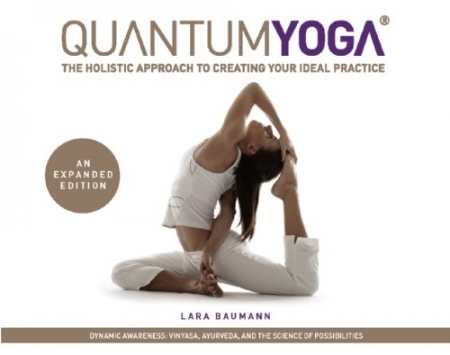Quantum Yoga
The Holistic Approach to Creating Your Ideal Practice
A combination of yoga and quantum physics, this approachable guide brings science to the mat.
Every style of yoga brings its own unique perspective to the practice. For example, Anusara yoga relies on Tantric philosophy and a methodology of “heart opening,” while Bikram yoga values precision and consistency in a heated studio. Other styles include Ashtanga, Yin, Iyengar, Power Yoga, and Kundalini, among many others. Into this array comes Quantum Yoga, a system that’s different from all others because it fuses quantum physics and the Indian medicine system, Ayurveda, while still retaining many of the basic postures already known to yoga enthusiasts.
Developed by yoga instructor Lara Baumann, who studied with major teachers Pattabhi Jois and B. K. S. Iyengar, the system fuses West and East artfully, in a way that doesn’t feel like Eastern ideas are co-opted, or that Western thoughts are diminished. Passionately written and easy to follow, Baumann’s guide provides extensive insight for those who may have tried other yoga styles and found them lacking.
In the book’s first section, Baumann describes the connection between yoga and quantum physics, articulating how the scientific discipline provides insight into how much we don’t know. This acknowledgment is vital in yoga, the author believes, because it creates a mind-opening pathway toward greater insight.
“There are limits to the level of conceptual understanding we can access,” she writes. “This is for the pure reason that the mind is directly involved in the manifestation of reality, so there is no way to divide the two. How can the mind know what the mind perceives, when in the very act of perceiving, it is shaping the reality it believes to be perceiving?”
Yoga is about achieving a state of knowing rather than one of knowledge, she adds, and, in subsequent sections that provide yoga sequences, she returns often to the idea of alignment and harmony with these philosophies. Baumann’s clear, forceful writing style is especially helpful when she describes specific postures, since she gives impressively detailed instructions about what a yogi should be feeling in his or her body during the pose.
In terms of design, the book is a stunner. Rich but simple layouts provide pose-by-pose instruction, and the distinctive trim size allows the book to lie flat so yogis can refer to it during a sequence.
The current wealth of yoga styles can leave some practitioners leery of new systems, but Baumann’s distinctive philosophies and sequences are refreshing. Definitely worth a try for anyone who wants more East-West integration in a practice.
Reviewed by
Elizabeth Millard
Disclosure: This article is not an endorsement, but a review. The publisher of this book provided free copies of the book to have their book reviewed by a professional reviewer. No fee was paid by the publisher for this review. Foreword Reviews only recommends books that we love. Foreword Magazine, Inc. is disclosing this in accordance with the Federal Trade Commission’s 16 CFR, Part 255.

